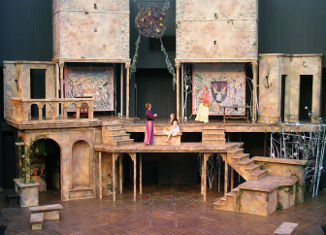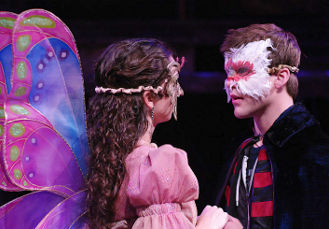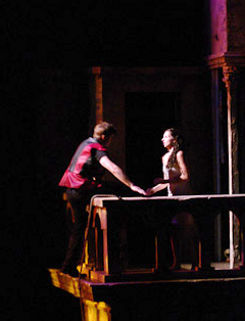Summary 
Effective tragedy scored with modern pop music and costumed with black jeans on the younger characters. A mid-20s Juliet and Romeo about ten years more mature than their characters, but a framing image haunts - a talisman of corpses embroiled in hell - and lends foreboding to the familiar romantic tragedy.
Design
Directed by Doug Finlayson. Costume design by Linda Pisano. Scenic design by Michael Franklin-White. Lighting design by R. Lee Kennedy. Sound design by Aaron Paolucci. Fights and choreography by DC Wright.
Cast
John Taylor Phillips (Capulet), Jessie Dean (Lady Capulet), Laura Rook (Juliet), Jan Rogge (Nurse), Nicholas Harazin (Tybalt), Michael Gamache (Montague), Melissa Graves (Lady Montague), Dylan Paul (Romeo), Andy Talen (Benvolio), Josh Innerst (Prince/Friar John), Santiago Sosa (Mercutio), Zack Powell (Paris), Stephen Spencer (Friar Laurence).
Analysis

Director Doug Finlayson offers a busy Prologue to set the mood for a partially modernized Romeo and Juliet at the 34th Illinois Shakespeare Festival. The production, effectively scored with modern pop and indie alternative music, features the younger characters costumed in jeans and boots or sneakers rather than the usual tights, and the more mature characters are attired in elaborate Renaissance costumes. The ensemble struggles to hoist high above the stage a graphic talisman of twisted bodies writhing in hell, as some characters, notably a noble young Benvolio, try to stop the symbolic perpetuation of violence. Amid thunder and lightning, Andy Talen's long-haired Benvolio - in black jeans and sneakers, wearing an Affliction "Live Fast" rock-and-roll T-shirt complete with winged skull - seems distraught at the ominous talisman, but turns and joins the rest of the ensemble as they face the audience and alternate the lines of prologue.
Finlayson begins 1.1 upon a burnished brown and tan stage that suggests sun-baked Verona, as Samson, wielding a club, and Gregory, with sword and shield, pick a tentative fight with a pair of Montagues. Samson reacts with sudden fear, dropping his club, and Talen's benevolent Benvolio succeeds for just a moment in preventing a brawl, but Tybalt descends stage left stairs and mayhem ensues. Alarm bells sound before the Prince, resplendent in cranberry-red robes, descends the stairs to stop the fighting. Dylan Paul makes his first appearance 1.2 as Romeo while Benvolio wraps an injured hand in a bloody white bandage. Paul's Romeo, big and burly but boyishly good looking - think a brawny and older Justin Bieber - wears jeans and boots with a black shirt under a red-striped black leather jacket, his knife secured in a scabbard. He cradles a rose in symbolic opposite to the blood on Benvolio's hand. 1.2 also introduces Laura Rook as Juliet, like Paul appearing to be in her early twenties, a good ten years more mature than their young teen characters. She appears in a small balcony at stage right, playfully chasing after a young boy with a stuffed lion. Onstage, Romeo is politely helpful with an illiterate Capulet, then eager to join Benvolio at the Capulet masque so he can continue his romantic pursuit of Rosaline. Rook's Juliet, tiny with long curly black hair, demonstrates her girlishness, hiding with a giggle 1.3 from the matronly but kind-hearted Nurse. Diminutive and dreamy, Rook's Juliet is far more convincing later in her expressive and strident - grown up too fast - Act 4 scenes.

Finlayson's 1.4 features a pirate-like Mercutio, the charismatic Santiago Sosa in goatee and black mask, carrying a wine sack, followed closely by Benvolio with a torch and a Montague beating a small drum. His mercurial Queen Mab speech proves him much like his close friend Romeo, both doomed and appearing aware of their doom. The 1.5 masque begins with a flowing blue and pink butterfly banner unfurled from Juliet's balcony, and the stage swarms with guests in masks and capes as Lord and Lady Capulet appear above to polite applause. A plaintive piano melody plays as Juliet arrives, winged like an angel, wearing glittery pink Converse high-top sneakers adorned with tiny butterflies. After dancers form a line and pair off in a stilted reel, Katy Perry's "Teenage Dream" plays - "we can dance until we die" - as Paul's Romeo halts thunderstruck halfway down the stairs, seeing Juliet for the first time. Torches burn as Capulet quells - for the moment - Tybalt's anger at Romeo's presence, but the dancers clap and slide away from center stage as Juliet and Romeo circle one another. Juliet removes his mask and they dance together - "we'll be young forever, you and I" - before sharing a gentle first kiss, though Paul's Romeo follows with a more passionate kiss, holding Juliet's face in his hands. They are abruptly parted, and they each pursue the other's identity - "my only love sprung from my only hate" - before Juliet ascends to the balcony and drapes herself in the butterfly banner, while Romeo drops to one knee onstage.

The 2.2 balcony scene further develops chemistry as Paul's Romeo jumps up on a stone bench, then down again, before diving away as Juliet calls out his name. When he responds, she screams and flees inside, and he climbs up to the balcony railing to gift her with a flower. Their interaction endears - she reaches for him and he crawls closer - and her tender words contrast with the sudden sharpness at the beckoning Nurse: "by and by I come!" Finlayson paces the production very well, moving quickly through 2.3 with Friar Laurence in bright sunshine as morning birds chirp to 2.4 with its ominous thunder as Benvolio kicks a soccer ball and mimics crowd cheers while Mercutio, now in a long black leather jacket, rudely teases Juliet's Nurse. Romeo struggles with his friend - the score now a haunting Sarah Jarosz melody: "tell me darling please tell me true" - and Juliet similarly endures her Nurse, who splashes her with water while supposedly catching her breath, delaying the news of the imminent nuptials. When Juliet meets Romeo and the Friar 2.6, Romeo speechlessly offers her another flower before the Friar must separate them from a lingering kiss and lead them to the marriage chapel.

The pivotal 3.1 begins in a blaze of mid-day heat and light, Sosa's Mercutio prowling at town center and pouring water over his head from a small fountain. When Tybalt arrives in gloves and boots, a dagger concealed behind his back, tempers flare and they duel, at one point Mercutio kissing Tybalt full on the mouth. Romeo intrudes and in sudden orange light and cessation of movement, Mercutio is stabbed - "a plague on both your houses" - and sags to his knees. To pounding rock music, Paul's Romeo impulsively grabs a rapier and assaults Tybalt, stabbing him twice - "I am fortune's fool!" - then is shoved offstage by Benvolio. Families arrive to martial drumbeats, Tybalt in a sweaty sprawl downstage right. Romeo watches from above as he is banished by the Prince, and the music ends in sudden silence, bringing intermission.
Finlayson begins his production's second act with alternating glimpses of Juliet and Romeo, Rook's Juliet wrapped again 3.2 in butterflies - "cut him out in little stars" - before becoming distraught in purple light not at Tybalt's death but at Romeo's banishment, and Paul's Romeo falls 3.3 to his hands and knees. The Nurse must strike Romeo to make him stand, then wipes his nose as if he is a child before the Friar takes away his knife in the feeble suicide attempt. After the quasi-comically complicated plan develops, the Friar offers Romeo his hand to shake, but Paul's Romeo instead embraces him. The 3.5 wedding night scene is subtly played - accompanied by "tell me darling, please tell me" melody - with Juliet in a nightgown upon a bed in the balcony, reaching for Romeo, who removes his shirt before a blackout. In the morning, she pulls him back to their bed by his shirt - "it is the nightingale" - and they kiss one another yet again.
Rook's Juliet - "I have an ill-divining soul" - rejects the idea of marriage to Paris, enduring her mother's coldness and her father's fury - "proud me no proud" - and in 4.1 continue to showcase her development into a strong-willed and independently thinking young woman. Physically confident and assured in tone, she visits a vegetable-slicing Friar 4.1, preventing a kiss with Paris by offering her hand, then secretly stealing Romeo's dagger as she accepts the vial. In 4.2 she offers feigned humility in an apology to her father, and in 4.3 she reveals anger at the Nurse's sudden allegiance to Paris - "peevish self-willed harlotry!" - although outwardly polite, and she embraces her mother, knowing she will never see the woman again. After she resolutely drinks from the vial, she wraps herself in the billowing butterfly blanket. The 4.5 discovery of her apparent corpse by the Nurse is not played with histrionics, but quiet gravity and solemn anguish - "o heavy day" - fading slowly to black.
Paul's Romeo reveals similar determination, captured 5.1 in a spotlight deep within the audience. Told of Juliet's seeming death, he hurries to the stage with tears in his eyes - "then I defy you, stars" - and debases himself with a visit to a drug lord Apothecary, although revealing sudden wisdom - "I sell the poison" - to creepy psychedelic acid rock music. Finlayson moves quickly to the 5.3 conclusion, staged within the Capulet crypt, as Romeo arrives to kneel beside Juliet upon a bier at center stage. The stage picture is blunted somewhat by a shrouded Capulet corpse downstage center that draws unwanted attention from the bittersweet reunion. Paul's Romeo dispatches Paris, then cuts the wax away from the opening of his bottle of poison - "this with a kiss I die" - lying next to Juliet not with showy melodramatic teenage emotion but genuine tenderness, a subtle and welcome interpretation. Rook's Juliet gasps and awakens to a haunting piano melody, stabbing herself with the stolen dagger before embracing Romeo and dying.
Finlayson does not conclude with this iconic image, but instead shows the arrival of the grief-stricken parents in glowing orange light. Benvolio, in representing the youth of Verona and a new generation, angrily draws his knife and flies up the stairs to cut down the talisman image of violence, then pivots to speak some of the Prince's lines to the characters and to the audience, effectively ending the somber production on a note of change and rising hope.